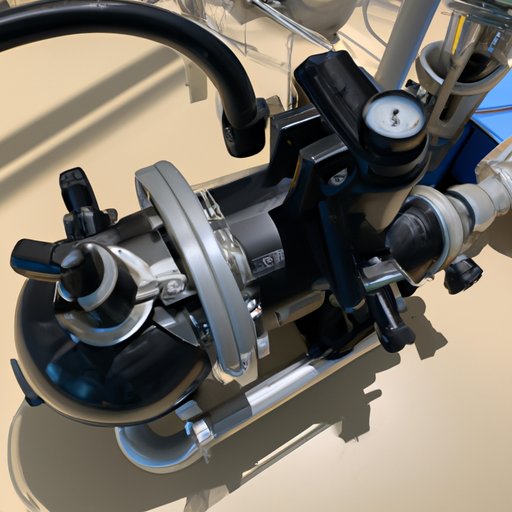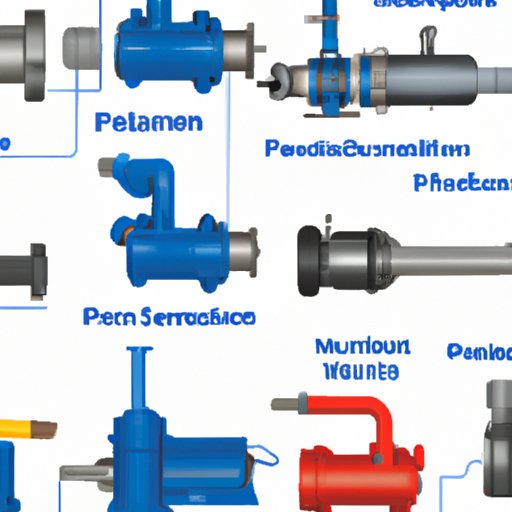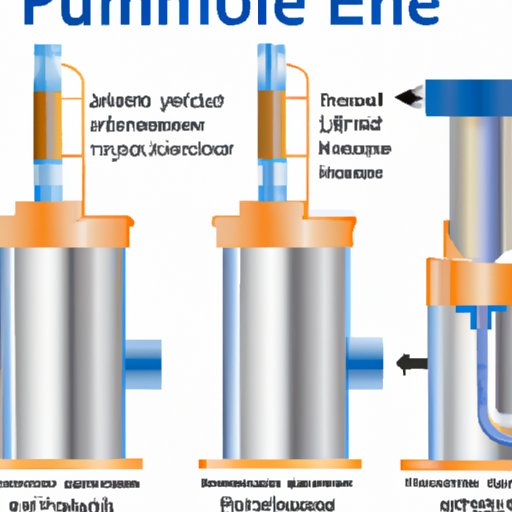Introduction
A pump is a mechanical device that uses suction or pressure to move liquids or gases from one place to another. Pumps are used in a variety of industries, including water treatment, industrial manufacturing, and automotive. In this article, we will explore the anatomy of a pump, the science behind how pumps operate, types of pumps and their applications, and common problems with pumps and how to fix them.
A Step-by-Step Guide to Understanding the Mechanics of a Pump
Before we dive into the specifics of how a pump works, let’s first take a look at its anatomy. A pump consists of two main parts: the internal components, which are responsible for creating the suction or pressure needed to move the liquid or gas; and the external components, which control the flow rate and direction of the media being moved.

Exploring the Anatomy of a Pump and How it Works
Internal Components
The internal components of a pump are responsible for creating the suction or pressure needed to move the liquid or gas. These components include the impeller (or rotor), the volute (or casing), the bearing assembly, and the motor. The impeller is a spinning wheel that creates the suction or pressure needed to move the liquid or gas. The volute is the housing that surrounds the impeller and helps direct the flow of the media. The bearing assembly is responsible for supporting the impeller and allowing it to spin freely. The motor is what drives the impeller and is usually powered by electricity, but can also be powered by other sources such as air or hydraulic pressure.
External Components:
The external components of a pump are responsible for controlling the flow rate and direction of the media being moved. These components include the inlet and outlet valves, the check valve, and the discharge pipe. The inlet and outlet valves control the flow rate of the media entering and exiting the pump. The check valve prevents the media from flowing back into the pump. And the discharge pipe directs the media away from the pump.
Operation of a Pump:
When the motor is activated, the impeller begins to spin, creating suction or pressure. This suction or pressure causes the media to move through the inlet valve and into the pump. As the media is pushed through the pump, it is directed by the volute and the discharge pipe. Finally, the media is forced out of the pump through the outlet valve.

Types of Pumps and Their Applications
There are several different types of pumps and each type has its own set of applications. The most common types of pumps are centrifugal pumps, positive displacement pumps, and vacuum pumps.
Centrifugal Pumps:
Centrifugal pumps use a rotating impeller to create suction or pressure. They are most commonly used in water treatment applications, such as pumping water from a well or river. They are also used in industrial manufacturing processes, such as pumping chemicals or oil.
Positive Displacement Pumps:
Positive displacement pumps use a piston or diaphragm to create suction or pressure. They are most commonly used in automotive applications, such as pumping fuel or lubricants. They are also used in industrial manufacturing processes, such as pumping viscous liquids or slurries.
Vacuum Pumps:
Vacuum pumps use a vacuum to create suction or pressure. They are most commonly used in medical applications, such as pumping oxygen or anesthesia. They are also used in industrial manufacturing processes, such as pumping corrosive chemicals or hazardous gases.
The Science Behind How Pumps Operate
In order for a pump to work properly, there must be a pressure difference between the inlet and outlet of the pump. This pressure difference is created by the impeller, which spins at a high speed and creates a low pressure area at the inlet of the pump. This low pressure draws the media into the pump, while the high pressure at the outlet forces the media out of the pump.
The flow rate of the media is determined by the size of the impeller, the speed at which it is spinning, and the pressure difference between the inlet and outlet of the pump. The efficiency of the pump is determined by the amount of energy required to turn the impeller and the amount of power consumed by the motor.

Benefits of Using a Pump in Various Industries
Pumps are used in a variety of industries for a variety of purposes. In the water treatment industry, pumps are used to move water from wells or rivers to treatment plants. In the industrial manufacturing industry, pumps are used to move chemicals, oils, and other fluids in production processes. And in the automotive industry, pumps are used to move fuel, lubricants, and other fluids in engines and transmissions.
Pumps offer many benefits over other methods of moving liquids or gases. They are more efficient than manual labor, require less energy to operate, and are more reliable than other methods. They are also easier to maintain and repair than other methods, making them a cost-effective solution for many industries.
Common Problems with Pumps and How to Fix Them
Despite their many benefits, pumps can experience problems due to wear and tear or improper maintenance. Common problems include leaks, corrosion, and blockages. Leaks can occur when the seals around the pump become worn or damaged. Corrosion can occur when the pump is exposed to harsh chemicals or environments. And blockages can occur when debris accumulates inside the pump.
Fortunately, these problems can usually be fixed with regular maintenance and repairs. Leaks can be fixed by replacing the seals around the pump. Corrosion can be prevented by coating the pump with a protective coating. And blockages can be cleared by removing the debris from the pump.
Conclusion
Understanding how a pump works is essential for anyone working in an industry that utilizes pumps. Pumps are a cost-effective and efficient way to move liquids and gases, but they can experience problems due to wear and tear or improper maintenance. By understanding the anatomy of a pump, the types of pumps and their applications, the science behind how pumps operate, and the common problems with pumps and how to fix them, you can ensure your pump operates efficiently and reliably.
(Note: Is this article not meeting your expectations? Do you have knowledge or insights to share? Unlock new opportunities and expand your reach by joining our authors team. Click Registration to join us and share your expertise with our readers.)
